| ID |
Image |
Oil Pantings, Sorted from A to Z |
Other Information |
| 88409 |
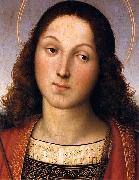 |
St Sebastian |
between 1501(1501) and 1502(1502)
Medium Oil on wood
cyf |
| 55705 |
 |
Story |
mk243
1518-1519
|
| 51296 |
 |
Study for the Disputa |
1509
Brush and white highlighting over stylus underdrawing, 280 x 285 mm |
| 55713 |
 |
Study of bury |
mk243
1507
182x205cm
|
| 55719 |
 |
Study of Mary |
mk243
|
| 63815 |
 |
The Adoration of the Magi |
1502-03 Oil on canvas, 27 x 150 cm Pinacoteca, Vatican Extant drawings demonstrate the tremendous amount of thought which Raphael put into the realization of the Oddi Altarpiece and some details, notably the highly individual faces of the Apostles and the serene landscape in the background, are quite masterful. But the most meaningful passages are found in the predella scenes: the vast space which opens out beneath the colonnades of the Annunciation; the highly animated Adoration of the Magi; and the free quality of the atmosphere in the Presentation in the Temple, which foreshadows the extraordinary spatial intuition of some of the artist's future Vatican compositions.Artist:RAFFAELLO Sanzio Title: The Adoration of the Magi (Oddi altar) Painted in 1501-1550 , Italian - - painting : religious |
| 8710 |
 |
The Adoration of the Magi (Oddi altar) set |
1502-03
Oil on canvas, 27 x 150 cm
Pinacoteca, Vatican |
| 8747 |
 |
The Alba Madonna |
1511
Oil on canvas, diameter 98 cm
National Gallery of Art, Washington |
| 86060 |
 |
The annunciation |
Date between 1502(1502) and 1503(1503)
Medium Deutsch: Öltempera auf Holz, auf Leinwand xbertragen.
English: Tempera grassa (egg-oil) on canvas.
Español: Óleo sobre lienzo.
Français : Tempera grassa (xmulsion x lxœuf et x lxhuile) sur bois transfxrxe sur toile.
Italiano: Tempera grassa su tavola trasportata su tela.
Dimensions Height: 27 cm (10.6 in). Width: 50 cm (19.7 in).
cjr |
| 90119 |
 |
The annunciation |
between 1502(1502) and 1503
cyf |
| 8709 |
 |
The Annunciation (Oddi altar, predella) t |
1502-03
Oil on canvas, 27 x 50 cm
Pinacoteca, Vatican |
| 52239 |
 |
The Baptism of Constantine |
1520-24 Fresco Stanza di Constantino |
| 52241 |
 |
The Battle at Pons Milvius |
1520-24 |
| 63798 |
 |
The Battle of Ostia |
1514-15 Fresco, width at base 770 cm Stanza dell'Incendio di Borgo, Palazzi Pontifici, Vatican In AD 849 the Arab fleet attacked the papal forces, but was destroyed by a storm. On the left, Leo IV, in the figure of Leo X, can be seen giving thanks. The scene is probably a reference to Leo's intentions to mount a crusade against the Turks. The fresco is the work of workshop assistants.Artist:RAFFAELLO Sanzio Title: The Battle of Ostia Painted in 1501-1550 , Italian - - painting : religious |
| 8730 |
 |
The Blessing Christ |
c. 1506
Oil on wood, 30 x 25 cm
Pinacoteca Tosio Martinengo, Brescia |
| 51225 |
 |
The Canigiani Madonna |
1507
Oil on wood,
131 x 107 cm |
| 51252 |
 |
The Cardinal Virtues |
1511
Fresco, width at the base 660 cm |
| 63808 |
 |
The Cardinal Virtues |
1511 Fresco, width at the base 660 cm Stanza della Segnatura, Palazzi Pontifici, Vatican The lunette above the scenes Justinian Presenting the Pandects to Trebonianus (left) and Gregory IX Approving the Decretals (right) represents the Cardinal Virtues. Fortitude can be recognized by her attribute, the lion; Wisdom, who has two faces, by her mirror; and Temperance by the reins. Fortitude is holding an oak branch, a reference to the pope's family name, Rovere, meaning "oak."Artist:RAFFAELLO Sanzio Title: The Cardinal Virtues Painted in 1501-1550 , Italian - - painting : religious |
| 51247 |
 |
The Coronation of Charlemagne |
1516-17 Fresco
|
| 51245 |
 |
The Creation of the Animals |
1518-19
Fresco Loggia on the second floor |
| 86394 |
 |
The Crowning of the Virgin |
Date between 1502(1502) and 1503(1503)
Medium Oil on canvas, transferred from panel
Dimensions Height: 267 cm (105.1 in). Width: 163 cm (64.2 in).
cjr |
| 8708 |
 |
The Crowning of the Virgin (Oddi altar) |
1502-03
Oil on canvas, 267 x 163 cm
Pinacoteca, Vatican |
| 51288 |
 |
The Death of Ananias |
1515
Tempera on paper |
| 88331 |
 |
The Engagement of Virgin Mary |
1504(1504)
Medium Oil on roundheaded panel
cyf |
| 8740 |
 |
The Entombment (detail) st |
1507
Oil on wood
Galleria Borghese, Rome |
| 8739 |
 |
The Entombment sys |
1507
Oil on wood, 184 x 176 cm
Galleria Borghese, Rome |
| 51243 |
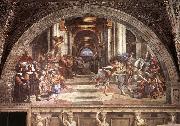 |
The Expulsion of Heliodorus from the Temple |
1511-12
Fresco, width at the base 750 cm |
| 63792 |
 |
The Expulsion of Heliodorus from the Temple |
1511-12 Fresco Stanza di Eliodoro, Palazzi Pontifici, Vatican Raphael's depiction of the Pope Julius II in the fresco is as penetrating as the London portrait of Julius. According to Vasari, the reason Raphael was so well-liked was probably because he portrayed so many people at the papal court to their satisfaction in these frescoes.Artist:RAFFAELLO Sanzio Title: The Expulsion of Heliodorus from the Temple (detail) Painted in 1501-1550 , Italian - - painting : religious |
| 63793 |
 |
The Expulsion of Heliodorus from the Temple |
1511-12 Fresco, width of detail: 230 cm Stanza di Eliodoro, Palazzi Pontifici, Vatican In the centre, the expanse of the wide nave, illuminated by the reflections of light in the vault, is a more effective space-determining motif than the large patches of blue sky which appeared through the coffered ceiling in the School of Athens.Artist:RAFFAELLO Sanzio Title: The Expulsion of Heliodorus from the Temple (detail) Painted in 1501-1550 , Italian - - painting : religious |
| 63790 |
 |
The Fire in the Borgo |
1514 Fresco Stanza dell'Incendio di Borgo, Palazzi Pontifici, Vatican The group in the left foreground, for example (made up of an old man on the shoulders of a young man, and a child), may be drawn from the episode of the Aeneid in which Aeneas escapes with his father, Anchises and his son, Ascanius. The nude descending from the wall at left recalls the heroic figures of Michelangelo.Artist:RAFFAELLO Sanzio Title: The Fire in the Borgo (detail) Painted in 1501-1550 , Italian - - painting : religious |
| 63791 |
 |
The Fire in the Borgo |
1514 Fresco Stanza dell'Incendio di Borgo, Palazzi Pontifici, Vatican The figures in the foreground are desperately trying to put out the fire.Artist:RAFFAELLO Sanzio Title: The Fire in the Borgo (detail) Painted in 1501-1550 , Italian - - painting : religious |
| 86971 |
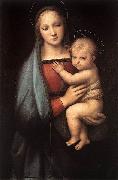 |
The Granduca Madonna |
1504(1504)
Medium Oil on wood
cyf |
| 8722 |
 |
The Granduca Madonna at |
1504
Oil on wood, 84 x 55 cm
Galleria Palatina (Palazzo Pitti), Florence |
| 51287 |
 |
The Handing-over the Keys |
1515
Tempera on paper |
| 84041 |
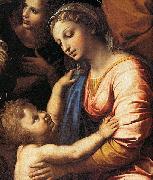 |
The Holy Family |
Date 1518(1518)
Medium Oil on canvas transferred from wood
cjr |
| 85310 |
 |
The Holy Family |
Date 1518(1518)
Medium Oil on canvas transferred from wood
Dimensions Height: 207 cm (81.5 in). Width: 140 cm (55.1 in).
cjr |
| 87902 |
 |
The Holy Family |
1518(1518)
Medium Oil on canvas transferred from wood
cyf |
| 51248 |
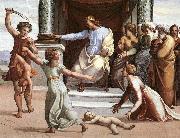 |
The Judgment of Solomon |
1518-19
Fresco Loggia on the second floor |
| 63803 |
 |
The Judgment of Solomon |
1510-11 Fresco, 120 x 105 cm Stanza della Segnatura, Palazzi Pontifici, Vatican The story from the Old Testament tells how two women came to Solomon to settle a dispute about which one was the mother of a child. When Solomon ordered the baby to be cut in half, one of the women agreed to give up the child. Solomon recognized her as the true mother. The man holding the sword derives from a classical figure, either Castor or Pollux from the Quirinal, an ancient Roman palace.Artist:RAFFAELLO Sanzio Title: The Judgment of Solomon (ceiling panel) Painted in 1501-1550 , Italian - - painting : religious |
| 63805 |
 |
The Liberation of St Peter |
1514 Fresco, width at base 660 cm Stanza di Eliodoro, Palazzi Pontifici, Vatican The story in the New Testament says that King Herod took Peter prisoner and intended to have him killed. In prison the Apostle was chained to two guards, but an angel of the Lord freed him despite the close watch. The fresco is dated 1514 on two painted tablets in the picture. The composition of this fresco clearly reflects the order and unity of the Mass of Bolsena. But the story is broken down into three distinct episodes, taken from the Acts of the Apostles. The first shows the dismay of the guards; the second the appearance of the Angel of Freedom in the saint's cell; the third, the bewildered Peter led by the hand of the divine messenger. The barred cell is on an upper level (like the altar in the Mass) and is reached by steps to the left and right. A group of agitated figures occupies the stairway at the left. Here, a soldier - whose armor reflects the light of the moon asks his sleepy and bewildered comrades what is going on. At right, the angel leads the stunned and still-sleepy St Peter past another sleeping guard. Here, for the first time, Raphael attempts a "night effect", using both the natural light of the moon and the autonomous light of the angel. Raphael's assistants played a greater role in painting the Eliodoro cycle than in the Stanza della Segnatura. This is clearly a consequence of the growing number of commissions which the Romans granted to Raphael. The hand of Giulio Romano, one of his most faithful pupils, is visible in the episode showing the Liberation of St Peter. This painting is the last fresco that can be attributed to Raphael with any certainty. The large cycles which follow (except for the Sibyls of Santa Maria della Pace) were entrusted mainly to assistants.Artist:RAFFAELLO Sanzio Title: The Liberation of St Peter Painted in 1501-1550 , Italian - - painting : religious |
| 63806 |
 |
The Liberation of St Peter |
1514 Fresco, width of detail: 235 cm Stanza di Eliodoro, Palazzi Pontifici, Vatican The story in this fresco is broken down into three distinct episodes, taken from the Acts of the Apostles. The second (in the centre) shows the appearance of the Angel of Freedom in the saint's cell.Artist:RAFFAELLO Sanzio Title: The Liberation of St Peter (detail) Painted in 1501-1550 , Italian - - painting : religious |
| 51255 |
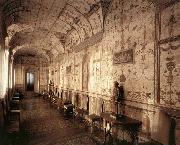 |
The Loggetta of Cardinal Bibbiena |
1516-17
Fresco Palazzi Pontifici |
| 51240 |
 |
The Loggia of Psyche |
1517
Fresco Villa Farnesina |
| 63788 |
 |
The Madonna of Foligno |
1511-12 Oil on canvas Pinacoteca, Vatican The papal secretary Sigismondo de'Conti donated this ex voto altarpiece in 1511. A meteorite had fallen on Conti's house, a catastrophe Conti himself survived. Raphael portrays this event in the background.Artist:RAFFAELLO Sanzio Title: The Madonna of Foligno (detail) Painted in 1501-1550 , Italian - - painting : religious |
| 51246 |
 |
The Mass at Bolsena |
1512 Fresco
width at the base 660 cm |
| 63799 |
 |
The Mass at Bolsena |
1512 Fresco, width of detail: 141 cm Stanza di Eliodoro, Palazzi Pontifici, Vatican As the priest raises the Host, two devotees lean over the semicircular screen which forms the background of the scene. This is a further attempt by Raphael to represent figures in a more dynamic way.Artist:RAFFAELLO Sanzio Title: The Mass at Bolsena (detail) Painted in 1501-1550 , Italian - - painting : religious |
| 63800 |
 |
The Mass at Bolsena |
1512 Fresco Stanza di Eliodoro, Palazzi Pontifici, Vatican Julius II had founded the Swiss Guard as a military elite in May 1510, and granted them the distinction of their own costume. The Guard had played a vital role in a victory over French forces, who had occupied parts of the Papal State. The pope was probably bestowing an honour on them for that loyal service by letting Raphael portray some of their important representatives in the fresco, thus giving them pride of place in his audience chamber.Artist:RAFFAELLO Sanzio Title: The Mass at Bolsena (detail) Painted in 1501-1550 , Italian - - painting : religious |
| 51251 |
 |
The Meeting between Leo the Great and Attila |
1514 Fresco |
| 63776 |
 |
The Miraculous Draught of Fishes |
1519 Tapestry in silk and wool, with silver-gilt threads, height 490 cm, width 441 cm Musei Vaticani, Vatican The tapestry was made by Pieter van Aelst, after a cartoon by Raphael Sanzio. Luke (5:1-11) recounts how Jesus, sitting in a boat, began teaching the multitudes on the shore. Then he asked Simon Peter to head towards deep water and cast the fishing nets again. Peter obeyed and they caught such a large amount of fish, that the nets began to break. They called for help and they filled both boats, so that they began to sink. Simon Peter fell down at Jesus' feet, saying "Depart from me, for I am a sinful man, O Lord!". For amazement had seized him and also James, son of Zebedee, his brother John and all their companions, because of the catch of fish which they had taken. And Jesus said to Simon "Do not fear, from now on you will be catching men." In the background, one can recognize the Vatican hill, with the towers along the wall of Leo IV, and Saint Peter's under construction. The cranes in the foreground, symbols of vigilance, are contrasted with the seagulls that allude to sin and apostasy. In the lower border two episodes in the life of Giovanni de'Medici (Pope Leo X) are depicted: on the left, his retinue, as he arrives in Rome for the conclave. On the right, the election of March 11, 1513. The border simulates a relief and is executed in chiaroscuro. Raphael's designs revolutionized the tradition of tapestry weaving, for they required a faithful rendering of atmosphere, light, textures, and pictorial form that had never been seen in this medium before. Here, for the first time, the usual monochrome background, or one depicting flowers and small ornaments, was abandoned in favour of a genuine pictorial space, in which the figures could move about.Artist:RAFFAELLO Sanzio Title: The Miraculous Draught of Fishes Painted in 1501-1550 , Italian - - graphics : religious |
| 51257 |
 |
The Parnassus |
1509-10
Fresco, width at base 670 cm
|
| 84138 |
 |
The presentation in the temple |
Date between 1502(1502) and 1503(1503)
Medium Deutsch: Öltempera auf Holz, auf Leinwand xbertragen.
English: Tempera grassa (egg-oil) on canvas.
Español: Óleo sobre lienzo.
Français : Tempera grassa (xmulsion x lxœuf et x lxhuile) sur bois transfxrxe sur toile.
Italiano: Tempera grassa su tavola trasportata su tela.
Dimensions Height: 27 cm (10.6 in). Width: 50 cm (19.7 in).
cjr |
| 87960 |
 |
The presentation in the temple |
Date between 1502(1502) and 1503
cyf |
| 8711 |
 |
The Presentation in the Temple (Oddi altar, predella) |
1502-03
Oil on canvas, 27 x 50 cm
Pinacoteca, Vatican |
| 63822 |
 |
The School of Athens |
1509 Fresco Stanza della Segnatura, Palazzi Pontifici, Vatican Geometry is represented by Euclid, who is explaining to his pupils a geometric diagram he has drawn on a slate. It is thought that Raphael was here portraying the architect Bramante.Artist:RAFFAELLO Sanzio Title: The School of Athens (detail) Painted in 1501-1550 , Italian - - painting : religious |
| 63823 |
 |
The School of Athens |
1509 Fresco Stanza della Segnatura, Palazzi Pontifici, Vatican Pythagoras, representing Arithmetic, is sitting in the foreground. The two men who are jostling to look over his shoulder recall figures in Leonardo da Vinci's unfinished Adoration of the Magi in the Uffizi. Raphael had occasion to study Leonardo's picture during his stay in Florence.Artist:RAFFAELLO Sanzio Title: The School of Athens (detail) Painted in 1501-1550 , Italian - - painting : religious |
| 51244 |
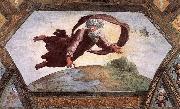 |
The Separation of Land and Water |
1518-19
Fresco Loggia on the second floor |
| 51239 |
 |
The Sibyls |
c. 1514
Fresco, width at base 615 cm |
| 63784 |
 |
The Sibyls |
1514 Fresco Santa Maria della Pace, Rome The detail shows the Tiburtine Sibyl.Artist:RAFFAELLO Sanzio Title: The Sibyls (detail) Painted in 1501-1550 , Italian - - painting : religious |
| 63779 |
 |
The Sistine Madonna |
1513-14 Oil on canvas Gem?ldegalerie, Dresden Generations of visitors to the Gem?ldegalerie in Dresden have been deeply impressed by the way in which Raphael portrayed the Madonna in this painting. It has been reproduced over and over again, and almost everyone is familiar with the putti leaning on the balustrade.Artist:RAFFAELLO Sanzio Title: The Sistine Madonna (detail) Painted in 1501-1550 , Italian - - painting : religious |
| 89282 |
 |
The Tempi Madonna |
1508(1508)
Medium oil on wood
cyf |
| 8720 |
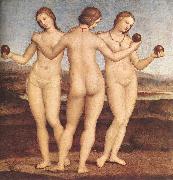 |
The Three Graces F |
1504-05
Oil on panel, 17 x 17 cm
Mus??e Cond??, Chantilly |
| 63783 |
 |
The Triumph of Galatea |
1511 Fresco, 295 x 225 cm Villa Farnesina, Rome The Sienese Banker, Agostini Chigi, played a very important role in the cultural and artistic activities which flourished around Julius II. His house was built on the outskirts of Rome in 1509-1510, and was designed as a model of luxury and elegance. He commissioned the most famous artists of the time, Baldassarre Peruzzi, Sebastiano Luciani (later called Sebastiano del Piombo) and Raphael himself to decorate it. All three painted frescoes based on classical mythology in Chigi's house (which was later acquired by the Farnese family and came to be known as "La Farnesina"). As subject Raphael chose a verse from a poem by the Florentine Angelo Poliziano which had also helped to inspire Botticelli's 'Birth of Venus'. These lines describe how the clumsy giant Polyphemus sings a love song to the fair sea-nymph Galatea and how she rides across the waves in a chariot drawn by two dolphins, laughing at his uncouth song, while the gay company of other sea-gods and nymphs is milling round her. Raphael's fresco shows Galatea with her gay companions; the giant is depicted in a fresco by Sebastiano del Piombo which stands to the left of Raphael's Galatea. However long one looks at this lovely and cheerful picture, one will always discover new beauties in its rich and intricate composition. Every figure seems to correspond to some other figure, every movement to answer a counter-movement. To start with the small boys with Cupid's bows and arrows who aim at the heart of the nymph: not only do those to right and left echo each other's movements, but the boy swimming beside the chariot corresponds to the one flying at the top of the picture. It is the same with the group of sea-gods which seems to be 'wheeling' round the nymph. There are two on the margins, who blow on their sea-shells, and two pairs in front and behind, who are making love to each other. But what is more admirable is that all these diverse movements are somehow reflected and taken up in the figure of Galatea herself. Her chariot had been driving from left to right with her veil blowing backwards, but, hearing the strange love song, she turns round and smiles, and all the lines in the picture, from the love-gods' arrows to the reins she holds, converge on her beautiful face in the very centre of the picture. By these artistic means Raphael has achieved constant movement throughout the picture, without letting it become restless or unbalanced. It is for this supreme mastery of arranging his figures, this consummate skill in composition, that artists have admired Raphael ever since. Just as Michelangelo was found to have reached the highest peak in the mastery of the human body, Raphael was seen to have accomplished what the older generation had striven so hard to achieve: the perfect and harmonious composition of freely moving figures. There was another quality in Raphael's work that was admired by his contemporaries and by subsequent generations - the sheer beauty of his figures. When he had finished the 'Galatea', Raphael was asked by a courtier where in all the world he had found a model of such beauty. He replied that he did not copy any specific model but rather followed "a certain idea" he had formed in his mind. To some extent, then, Raphael, like his teacher Perugino, had abandoned the faithful portrayal of nature which had been the ambition of so many Quattrocento artists. He deliberately used an imagined type of regular beauty. If we look back to the time of Praxiteles, we remember how what we call an "ideal" beauty grew out of a slow approximation of schematic forms to nature. Now the process was reversed. Artists tried to modify nature according to the idea of beauty they had formed when looking at classical statues - they "idealized" the model. It was a tendency not without its dangers, for, if the artist deliberately "improves on" nature, his work may easily look mannered or insipid. But if we look once more at Raphael's work, we see that he, at any rate, could idealize without any loss of vitality and sincerity in the result. There is nothing schematic or calculated in Galatea's loveliness. She is an inmate of a brighter world of love and beauty - the world of the classics as it appeared to its admirers in sixteenth-century Italy.Artist:RAFFAELLO Sanzio Title: The Triumph of Galatea Painted in 1501-1550 , Italian - - painting : mythological |
| 8745 |
 |
The Triumph of Galatea (detail) |
1511
Fresco
Villa Farnesina, Rome |
| 8746 |
 |
The Triumph of Galatea (detail) |
1511
Fresco
Villa Farnesina, Rome
|
| 8736 |
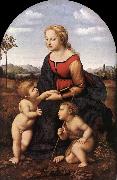 |
The Virgin and Child with Saint John the Baptist (La Belle Jardinire) af |
1507
Oil on wood, 122 x 80 cm
Mus??e du Louvre, Paris |
| 55639 |
 |
The virgin mary |
mk243
1502-1503
Oil on canvas
267x163cm
|
| 55669 |
 |
The virgin mary |
mk243
1507
122x80cm
|
| 55675 |
 |
The virgin mary |
mk243
1510
Oil on canvas
|
| 55678 |
 |
The virgin mary |
mk243
1508
81x57cm
|
| 55682 |
 |
The virgin mary |
mk243
1510-1511
68x48cm
|
| 55684 |
 |
The virgin mary |
mk243
1511
160x126cm
Oil on board
|
| 55686 |
 |
The virgin mary |
mk243
1511-1512
120x90cm
|
| 55687 |
 |
The virgin mary |
mk243
1511-1512
320x194cm
Oil on canvas
|
| 55688 |
 |
The virgin mary |
mk243
1511-1512
Oil on canvas
|
| 55700 |
 |
The virgin mary |
mk243
1513-1514
265x196cm
Oil on canvas
|
| 55711 |
 |
The virgin mary |
mk243
1504
|
| 55714 |
 |
The virgin mary |
mk243
1506
|
| 55668 |
 |
The virgin mary and John |
mk243
1507
107x77cm
|
| 55650 |
 |
The virgin mary on the grass |
mk243
1506
113x88cm
Oil on board
|
| 55638 |
 |
The virgin mary and christ |
mk243
1496-1497
97x67cm
|
| 55715 |
 |
The virgin mary and John |
mk243
17.3x21cm
|
| 55690 |
 |
The virgin mary and younger John |
mk243
1514
66x51cm
Oil on canvas
|
| 55692 |
 |
The virgin mary in the chair |
mk243
1514
Oil on board
|
| 55693 |
 |
The virgin mary in the chair |
mk243
1514
Oil on board
|
| 88341 |
 |
The Vision of Ezekiel |
1518(1518)
Medium Oil on wood
cyf |
| 63819 |
 |
Theological Virtues |
1507 Oil on wood, 16 x 44 cm (each) Pinacoteca, Vatican The three compositions (Faith, Hope and Charity), executed in a delicate monochrome, formed the predella belonging to the Entombment now in the Borghese Gallery, Rome. Both the main panel and the predella were carried from Perugia to Rome by Pope Paul V. They were replaced by copies in 1608.Artist:RAFFAELLO Sanzio Title: Theological Virtues Painted in 1501-1550 , Italian - - painting : mythological |
| 55663 |
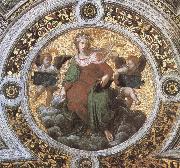 |
Theology |
mk243
1508
|
| 55667 |
 |
Theology |
mk243
1507
16x44cm
|
| 63796 |
 |
Theology |
1509-11 Fresco, diameter 180 cm Stanza della Segnatura, Palazzi Pontifici, Vatican Theology's veil is white, her cloak green, and her dress red, the colours of the theological Virtues (Faith, Hope, and Charity). She is holding a book in her left hand and is pointing with her right hand at the fresco of the Disputa below. Two putti are holding blue tablets with the golden inscriptions Divinar, Rer and Notitia ("Knowledge of Divine Things").Artist:RAFFAELLO Sanzio Title: Theology (ceiling tondo) Painted in 1501-1550 , Italian - - painting : religious |
| 55647 |
 |
Three woman |
mk243
1504-1505
17x17cm
Oil on board
|
| 57240 |
 |
Together with a friend of a self-portrait |
mk255 for in 1519. 0.99 x 0.83 meters canvas. Paris Louvre |
| 51221 |
 |
View of the Stanza della Segnatura |
1510-11 |
| 51242 |
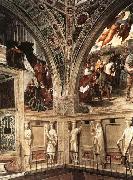 |
View of the Stanza di Eliodoro |
c. 1512 |
| 55642 |
 |
Virgin Mary |
mk243
1504
|
| 55653 |
 |
Virgin Mary and her son |
mk243
1506
274x152cm
|
| 51249 |
 |
Vision of the Cross |
1520-24
Fresco Stanza di Constantino |
| 63807 |
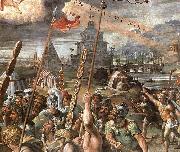 |
Vision of the Cross |
1520-24 Fresco Stanza di Constantino, Palazzi Pontifici, Vatican The view of the "Tomb-pyramid of Romulus", which is no longer there, and the so-called Citadel of Sant'Angelo together with the bridge of Sant'Angelo, is an example of Raphael's interest in ancient Rome. The view Raphael has chosen more or less matches the view he had of Rome in 1520 from his Vatican loggie, which are located right behind the wall painted with the fresco. The Citadel of Sant'Angelo appears to be Raphael's reconstruction of the original ancient building, the erstwhile Hadrian Mausoleum, as it might have looked in the days of Emperor Constantine. By depicting this view of ancient Rome, Raphael is suggesting to anyone viewing that fresco that Constantine experienced his vision in the precise place where the Vatican State is now located. By this means Raphael was able to confirm in a very subtle manner, that the Popes had established themselves in Rome - more specifically - in the Vatican.Artist:RAFFAELLO Sanzio Title: Vision of the Cross (detail) Painted in 1501-1550 , Italian - - painting : historical |
| 88268 |
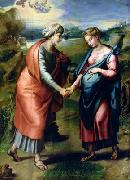 |
Visitation |
1517(1517)
Medium Oil on canvas
Dimensions 200 x 145 cm (78.7 x 57.1 in)
cjr |
| 51295 |
 |
Waist-length Figure of a Young Woman |
1506
Pen and ink over stylus underdrawing, .
262 x 189 mm |
| 55694 |
 |
Ware |
mk243
1514-1515
|